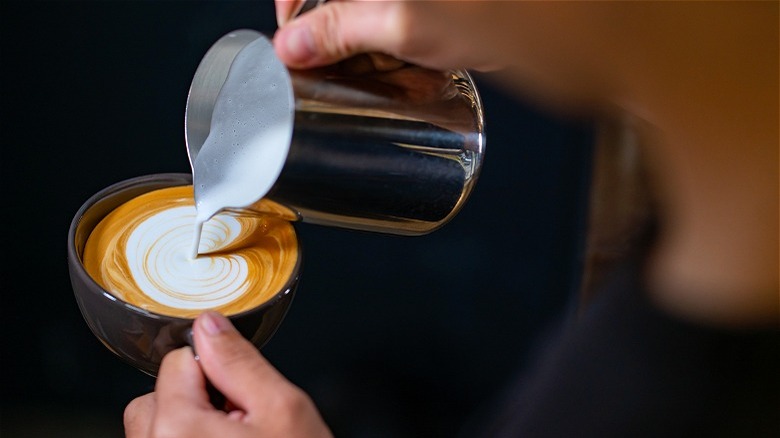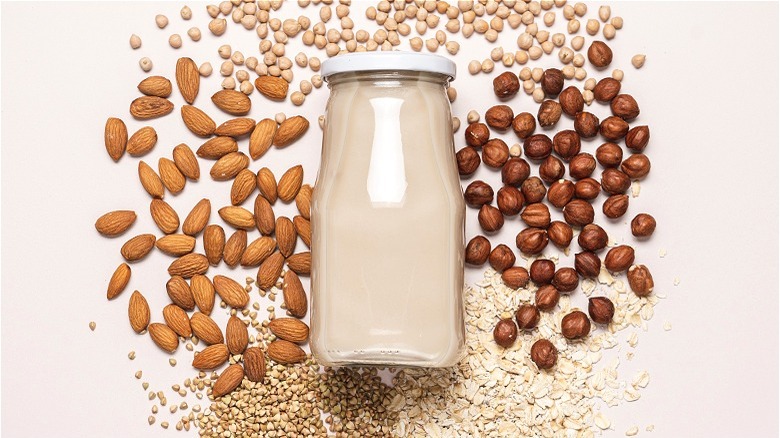The One Ingredient That Will Make Or Break Your At-Home Cappuccino
If you've recently decided to treat yourself to a high-end espresso maker, whether you choose to make a traditional latte, cappuccino, or macchiato, each milk-infused beverage has its own methodology and ratio of ingredients. When looking at the distinct differences between a latte and a cappuccino, espresso bar owner Fabrizio Franco explained to PureWow that a latte has significantly more milk while a cappuccino is made up of three crucial layers: Espresso, hot milk, and a signature layer of foam.
In fact, the word "cappuccino" reflects the color of the frothy European beverage. According to Britannica, Italian Capuchin Friars of the Roman Catholic church wore brown robes, yet often removed the attached hoods exposing their white hair, hence the connection between frothy milk and espresso. The New York Times points to the evolution of the American cappuccino in the late 1980s with the rise of Starbucks, and while you may be one of many who argue that our nation's version has way too much milk, cappuccinos are still considered to be one of the most popular espresso-based drinks available. The U.S. National Coffee Association recently discovered that 43% of coffee drinkers prefer espresso-based beverages like lattes and cappuccinos over a standard cup of java. If you're a specialty coffee lover, you may want to pay extra attention to one particular ingredient the next time you're in the mood for a cappuccino.
The quality of milk makes all the difference
When you want a refreshing coffee beverage you might reach for a Dalgona coffee, but if a creamy espresso-filled cappuccino is what you're after, knowing the best way to make the luscious coffee staple will ensure the enjoyment of your efforts. Recently the founder of the Invita Cafe in California, Sara de Luca, revealed to The Kitchn her essential tips for crafting the perfect cappuccino. Beyond her suggestions regarding cup temperature and encouraging creativity with additional ingredients besides milk and espresso, Luca details the importance of fresh milk. "If your milk is good your cappuccino shouldn't need sugar," Luca states. But what does that mean exactly?
According to Cru Kafe, milk's fat content affects the overall consistency of a cappuccino and if you're using cow's milk, there is some interesting science to consider. The sugar found in cow's milk known as lactose isn't necessarily sweet when consumed cold, but in the steaming process, breaks down and melts, giving off a sweeter flavor. When it comes to the recommended temperature of your steamed milk, Cru Kafe believes anywhere between 135-150 degrees Fahrenheit will draw out that much-welcomed hidden sweetness. Yet, the Perfect Daily Grind believes the fat content, not the exact temperature is the true indicator of how sweet your freshly made cappuccino will be. With all of this in mind though, can you make a delicious cappuccino with plant-based milk?
The wide range of plant-based cappuccinos
The idea of veering off the whole milk path to make your next cappuccino may seem incredibly intimidating, especially since the Italian Barista School claims fresh's cow's milk is the most used milk in Italy due to the balance it provides against that sharp espresso flavor. However, some coffee companies have taken the time to test the various options available, and apparently, some varieties hold up better than others.
While there has yet to be a review on the use of banana milk, Clive Coffee tested an array of plant-based milk to determine which had the best steaming capability in fulfilling all your espresso-driven artistic desires. Predictably, organic cow's milk took the number one spot on the list, yet barista-centered almond milk and oat milk both provided a creamy consistency against the backdrop of bitter espresso. The milk alternatives Clive Coffee strongly advised against were hemp, coconut, and cashew due to its complete inability to create "microfoam," hence a proper cappuccino.
Full Roast Coffee agrees with this assessment, arguing that almond milk is the best dairy-free choice due to its naturally sweet flavor. Additionally, almond milk has the ability to foam like regular whole milk if brought to room temperature first. There are some solid options for creating a dairy-free cappuccino and Clive Coffee reminds coffee enthusiasts that each brand of plant milk provides a varying degree of sweetness due to the ingredients used.


